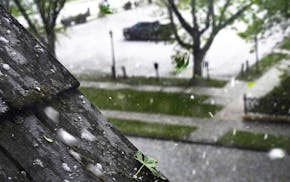A Twin Cities group is building a new kind of apartment for young adults who are developmentally disabled, a housing model they are touting as one that could meet a need for families with aging parental caregivers.
Since the 1970s, children and teens who are developmentally disabled have mostly lived at home with their parents or other relatives.
Now as adults, many are still living at home even as their parents grow older and less capable of providing them the help they still need. This, advocates say, is becoming a national crisis as the United States sees its first generation of people who are developmentally disabled outlive their parents — because of better health care.
Minnetonka-based Jewish Housing and Programming (J-HAP) estimates that 101,000 of the 135,000 developmentally disabled adults in the Twin Cities live at home; nationally, it's 6.75 million out of 9 million. Across the country, 25 percent of those caregivers are at least 60 years old, while another 40 percent are between the ages of 41 and 59.
Also part of the problem is that living with relatives or in scattered group homes can contribute to a pervading sense of social and spiritual isolation for these young adults once they have completed their school years, J-HAP says.
In response, the group teamed with Minneapolis-based nonprofit builder Community Housing Development Corporation (CHDC) and UrbanWorks Architecture to design what they hope will be replicable prototype of a new kind of supportive housing for young adults who are developmentally disabled: Cornerstone Creek, a 45-unit, $12 million building now under construction at 9300 Golden Valley Road in Golden Valley. It is set for a fall 2016 opening.
J-HAP President and founder Linda Bialick says its innovations are numerous, but mostly, it's an effort to combine the feeling and social community of apartment living with an availability of care. In a critical twist, residents can continue using the service providers they had at home rather than being restricted to the one supplied by the housing operator, which is often the case with other types of supportive housing.
"This model is about choice," Bialick said. "The idea [with Cornerstone Creek] is to give our kids the dignity of a home of their own. They will each sign a lease and pay rent like any kind of apartment. But they can choose to keep services they have always had. What we will do is merely coordinate the various caregivers within the building."
"The challenge is the disabled have been removed from the community, and even in group home settings, they may not have much in common with the other residents," added Heidi Rathmann, a vice president with Community Housing Development Corp. "The supportive housing model has been proven to work with other groups but has never really been tried for the developmentally disabled."
Rathmann says her nonprofit will own and operate the property, and as a very active housing developer with more than 4,300 units in its portfolio, the group is attracted to the potential of replicating the concept elsewhere.
With Cornerstone Creek, CDHC worked closely with Tod Elkins and David Miller of UrbanWorks to design a multifamily housing concept that would work to encourage independent living for a type of resident who may have never had the experience before.
"The building is set up in two wings, and on each of the three floors there are eight units clustered around a wing," Miller said. "Each of these areas has its own 'neighborhood' community room. So the design is really about fostering community, both at a larger scale with the building as a whole, and then breaking it down further with these neighborhoods."
The plans also include an outdoor courtyard with areas that can be programmed for resident activities. Meanwhile, the building's energy efficiency and sustainability features ensure lower operating expenses, a crucial feature for nonprofit operators of supportive housing.
Don Jacobson is a freelance writer based in St. Paul. He is the former editor of the Minneapolis-St. Paul Real Estate Journal.

Why do so many Minnesota homeowners get free roofs after a hailstorm?
Minnesota state parks press on with camping reservation system tweaks

A plume of PFAS chemicals under the east metro is moving. The state has a new plan to stop it.

Andover High School teacher leads effort for more understandable driver's tests

